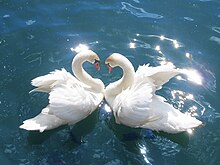Paramahamsa

Paramahamsa (
Etymology
This section possibly contains original research. (February 2013) |

Paramahamsa is a Sanskrit word translated as 'supreme swan'. The word is compounded of Sanskrit परम parama meaning 'supreme', 'highest', or 'transcendent' (from
In keeping with the construct of Sanskrit, which often layers multiple meanings upon or within words,
Mythology
The hamsa (swan) is the vahana, the mount or vehicle, of the god Brahma. In the Vedas and the Purânas it is a symbol for the soul/Soul. The hamsa is said to be the only creature that is capable of separating milk from water once they have been mixed; symbolically this is the display of great spiritual discrimination. It is symbolic for a spiritually advanced being who is capable of controlling the breath energy in such a way that he only absorbs pure vibrations from all the different energies the world contains. To the Paramahamsa (the supreme celestial Swan) on the other hand, the whole of creation is God himself, there is nothing else but God alone. This person is a fully realized soul, completely liberated from all bonds with the world, who knows no obligations, no likes or dislikes. He is without any needs because he is completely immersed in God.
Theology
Paramahamsa, as a religio/theological title, is applied to an adept class of Hindu renunciates, liberated, realized masters who, having attained the supreme yogic state, or
The hamsa mantra indicates the sound made by the exhalation ("ha") and inhalation ("sa") of the breath.
Privileged use
Some followers believe title cannot be assumed by oneself, but must be conferred by a recognized authority, either another individual swami who is himself esteemed as enlightened, or by a committee of spiritual leaders.[citation needed]
Other meaning
Paramahaṃsa is also the title of one of the
Paramahamsa title personalities
- Srila Bhaktiratna Sadhu Maharaj
- Abhiram Parmahansa
- Chandradhoja Paramahansa Dev
- Dayanidhi Paramahansa Dev
- Paramahamsa Shri Gajanan Maharaj
- Kalna Paramhansa
- Lahiri Mahasaya
- Narayana Guru
- Nigamananda Paramahansa
- Paramahamsa Hariharananda
- Paramahamsa Prajnanananda
- Paramahamsa Vishwananda
- Paramahansa Yogananda
- Paramhansa Acharya Yogiraj Balkrishananda 'Mukta-Buddha'
- Paramhansa Nikhileshwarananda
- Paramahamsa Nithyananda
- Paramhansa Swami Niranjanananda Saraswati
- Paramhansa Swami Satyasangananda Saraswati
- Paramhansa Swami Satyananda Saraswati
- Ramakrishna Paramahamsa
- Sadanand ji Paramhansa
- Sivananda paramahamsa vadakara
- Shivdharmanand Paramahansa
- Srimad Durga Prasanna Paramahansa Dev
- Akhandamandaleshwer Swarupananda Paramhansa Deva alias Babamani
- Paramhamsa Vishwananda
Notes
- ^ In Sanskrit, a pre-consonantal nasal is written with a diacritic dot (the Anusvara) above the preceding character. The exact realization of the nasalization must be inferred from the context. Thus, we have Paramahaṃsa, Paramahamsa, Paramahaṇsa, and Paramahansa as equivalent transliterations.
References
- ISBN 0-87612-030-3.
- ^ "Merriam-Webster Dictionary". Retrieved 2012-06-21.
- ^ Yoganandasite (2016-03-02). "The Meaning and Spelling of the Title "Paramahansa"". Yogananda Site. Retrieved 2021-04-30.
- ^ Yoganandasite (2016-03-02). "The Meaning and Spelling of the Title "Paramahansa"". Yogananda Site. Retrieved 2021-04-30.
- )
- S2CID 214405893, retrieved 2021-04-30
- ISSN 1531-2054.
- ^ "What Is Advaita or Nonduality?". endless-satsang.com. Retrieved 2021-04-30.
External links
- Hindu lexicon
- Hindu glossary
- Hamsa - The Bar-headed Goose, Anser indicus
